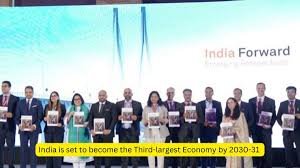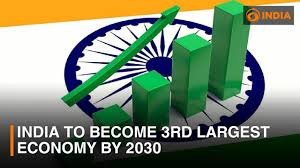India is Set to Become the Third-Largest Economy by 2030-31
India is on track to become the third-largest economy by 2030-31, according to economic analysts. This prediction is based on the nation’s robust growth rate, increased investments, and strategic reforms in key sectors such as manufacturing, infrastructure, and technology. With a projected Gross Domestic Product (GDP) of over $10 trillion, India will likely surpass Germany and Japan to secure the third spot after the United States and China. This monumental growth is a result of economic policies that focus on increasing domestic production and enhancing trade relationships.
Focus on Infrastructure and Manufacturing
One of the key drivers behind India’s growth is its focus on infrastructure and manufacturing. The government’s initiatives like ‘Make in India’ and ‘Atmanirbhar Bharat’ (Self-reliant India) have paved the way for large-scale investments in manufacturing hubs. Additionally, infrastructure projects like the Bharatmala and Sagarmala have boosted logistics and transportation, making it easier for businesses to thrive. The development of smart cities and advancements in technology have also played a pivotal role in attracting foreign direct investments (FDI), pushing India towards becoming an economic powerhouse.
Technological Advancements and Innovation
Technology and innovation have been central to India’s growth strategy. With increasing focus on digital transformation, India has become a global leader in the Information Technology (IT) and digital services sectors. Innovations in areas like Artificial Intelligence (AI), fintech, and e-commerce are helping to shape the country’s economy for the future. The government’s emphasis on Digital India and Start-Up India campaigns has further propelled the country’s technological growth, contributing to GDP expansion.
Trade Relations and Global Partnerships
India’s growing influence on the global stage is evident through its evolving trade relationships and strategic alliances. The country has established strong partnerships with major global economies, including the United States, European Union, and Southeast Asian countries. Free trade agreements and participation in international economic forums like the G20 have also contributed to India’s growing prominence in the global economy. These partnerships not only enhance trade but also promote technological exchange and investment opportunities, further solidifying India’s economic position.
Economic Reforms and Policy Changes
The Indian government has implemented a series of reforms aimed at improving the ease of doing business and attracting investment. Measures like the Goods and Services Tax (GST), Insolvency and Bankruptcy Code (IBC), and labour law reforms have streamlined the regulatory environment, making India a more attractive destination for both domestic and international investors. These reforms have boosted investor confidence, leading to increased capital flows, job creation, and overall economic stability.
Challenges Ahead
While India’s economic growth trajectory is impressive, challenges remain. The country faces issues such as income inequality, unemployment, and environmental concerns. Addressing these problems will require targeted reforms and sustainable policies. Despite these hurdles, the future of India’s economy looks promising as it continues to evolve into a global economic leader.

Why This News is Important
India’s Global Economic Position
India’s potential to become the third-largest economy by 2030-31 is significant for both the country and the world. This milestone reflects India’s growing influence on global economic matters and its importance as a key player in international trade and diplomacy. For students preparing for government exams, understanding India’s economic rise is crucial as it could impact multiple policy decisions, from trade to foreign relations.
Impact on Domestic Policies
This news is also crucial because it highlights the success of the government’s economic policies like ‘Make in India’ and ‘Atmanirbhar Bharat’. These initiatives are not only about boosting GDP but also about creating job opportunities, improving infrastructure, and enhancing technology-driven sectors. Future policies will likely continue to focus on these areas, which makes this topic highly relevant for exams that test knowledge of current government schemes and economic reforms.
Implications for Employment and Growth
As India grows economically, it will create new job opportunities and increase investments in sectors like technology, manufacturing, and infrastructure. For students aiming for government positions in sectors like banking, railways, and civil services, this growth indicates a future of improved job prospects and enhanced economic stability. Understanding the factors driving this growth can be essential for questions related to economic planning and development in competitive exams.
Historical Context
India’s Economic Evolution
India’s economic journey began in 1991 when it opened up to globalization and liberalization. Before this, the country followed a largely socialist economic model, which focused on self-reliance but limited foreign trade and investments. The 1991 reforms, under the leadership of then Prime Minister P.V. Narasimha Rao and Finance Minister Dr. Manmohan Singh, transformed the Indian economy by encouraging foreign direct investment (FDI) and privatization. Since then, India has steadily moved up the ranks, from being one of the poorest nations post-independence to a global economic force today.
Reforms That Shaped the Economy
Several reforms have been instrumental in India’s economic transformation. The introduction of the Goods and Services Tax (GST) simplified the tax system, boosting trade and commerce. The Insolvency and Bankruptcy Code (IBC) helped resolve financial distress in businesses, allowing for better management of bad loans. Labour law reforms have also made it easier for industries to hire, thereby driving job creation. These reforms, along with continuous infrastructure development, have set the stage for India’s future economic growth.
Historical Trade Relations
India has had a long history of trade dating back to the ancient Silk Route. During the colonial period, the British exploited India’s resources, hampering its economic growth. Post-independence, India initially pursued a policy of protectionism, but this changed dramatically after the 1991 reforms. Today, India enjoys trade relationships with over 150 countries, including major economies like the United States, China, Japan, and the European Union.
Key Takeaways from “India is Set to Become the Third-Largest Economy by 2030-31”
| S.No. | Key Takeaway |
|---|---|
| 1 | India is projected to become the third-largest economy by 2030-31, with a GDP exceeding $10 trillion. |
| 2 | Economic growth is driven by initiatives like ‘Make in India’ and ‘Atmanirbhar Bharat,’ focusing on manufacturing and infrastructure. |
| 3 | Technological advancements, including digital services and innovations in AI and fintech, are boosting India’s economic prospects. |
| 4 | India’s global trade relationships and participation in international forums like the G20 are strengthening its economic position. |
| 5 | Key reforms such as GST, IBC, and labour law reforms have improved the ease of doing business, attracting domestic and international investments. |
Important FAQs for Students from this News
1. What factors contribute to India becoming the third-largest economy by 2030-31?
India’s projected growth is driven by significant investments in manufacturing and infrastructure, technological advancements, and strategic global trade relationships.
2. How does the ‘Make in India’ initiative impact the economy?
The ‘Make in India’ initiative encourages domestic manufacturing, attracts foreign investments, and aims to create job opportunities, which collectively boost the GDP.
3. What role does technology play in India’s economic growth?
Technology fosters innovation in sectors like IT, fintech, and e-commerce, enhancing productivity and making India a leader in digital services.
4. Why are international trade relations important for India’s economy?
Strong trade relations with countries like the US and EU facilitate investment, technology exchange, and improve India’s position in global markets.
5. What challenges does India face despite its economic growth?
India faces issues like income inequality, unemployment, and environmental concerns, which need to be addressed to ensure sustainable growth.
Some Important Current Affairs Links















